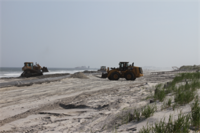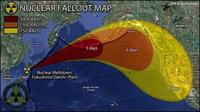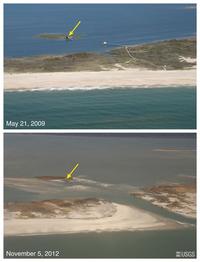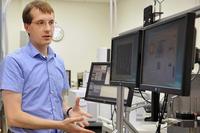-
Jersey shore towns build protection against future storms

Mantoloking and Brick townships in New Jersey were among the hardest hit by Superstorm Sandy. The storm also destroyed the natural dune barriers which offered a measure of protection. The two cities have decided to take action to minimize the damage of inflicted by a future storm: a $40 million project will see a steel wall —extending sixteen feet above the beach with a depth of thirty-two feet below the ground, and covered in sand to form an artificial dune — will run along the length of the two towns.
-
-
Fukushima radioactive plume to reach U.S. next year

The radioactive ocean plume from the 2011 Fukushima nuclear plant disaster will reach the shores of the United States within three years from the date of the incident, but is likely to be harmless, according to a new study. While atmospheric radiation was detected on the U.S. west coast within days of the incident, the radioactive particles in the ocean plume take considerably longer to travel the same distance.
-
-
Understanding the effects of wildfire smoke improves climate change models
Where there is wildfire, there is smoke — a lot of it. Those vast, carbon-laden clouds released by burning biomass can play a significant role in climate change. Not much is known, however, about the different types of particles in wildfire smoke and how they affect climate. Now researchers have uncovered some of their secrets. In particular, they studied an important component of smoke that has so far been absent from most models of climate change.
-
-
3D Earth model accurately pinpoints source of earthquakes, explosions
During the cold war, U.S. and international monitoring agencies could spot nuclear tests and focused on measuring their sizes. Today, they are looking around the globe to pinpoint much smaller explosives tests. Researchers are working on developing a 3-D model of the Earth’s mantle and crust called SALSA3D. The purpose of this model is to assist the U.S. Air Force and the international Comprehensive Nuclear-Test-Ban Treaty Organization (CTBTO) in Vienna, Austria, more accurately locate all types of explosions.
-
-
Beach erosion by Hurricane Sandy leaves coastal communities more exposed to future storms
Barrier islands provide natural protection against storms, shielding coastlines from rising waves and tides. Beaches and dunes on Fire Island, New York, lost more than half of their pre-storm volume during Hurricane Sandy, and the loss of so much sand increases the vulnerability of this area of coastline to future storms.
-
-
Remapping coastal areas damaged by Hurricane Sandy

Hurricane Sandy caused wide-scale landscape-altering destruction, resulting in an estimated damage of $50 billion, making Sandy the second-costliest cyclone to hit the United States since 1900. “Sandy’s most fundamental lesson is that storm vulnerability is a direct consequence of the elevation of coastal communities in relation to storm waves,” says USGS Kevin Gallagher. Three federal agencies are using ships, aircraft, and satellites to measure water depth, look for submerged debris, and record altered shorelines in high priority areas from South Carolina to Maine.
-
-
New technology improves IED detection

Improvised explosive devices, or IEDs, are homemade bombs that can both injure and kill civilians and service members. One solution to the problem of IEDs is to find them before they explode by detecting the chemicals used in the explosives. Scientists at the U.S. Naval Research Laboratory (NRL) have developed a technology, using silicon to fabricate a sensor that may revolutionize the way trace chemical detection is conducted
-
-
Unmanned undersea platform network to help better deploy naval capabilities
Today’s naval forces rely primarily on highly capable multifunctional manned platforms, such as ships and submarines. Even the most advanced vessel, however, can only be in one place at a time, making the ability to respond increasingly dependent on being ready at the right place at the right time. New Hydra program aims to make it easier, faster, and cheaper to deploy crucial capabilities worldwide.
-
-
Young scientists to tackle DoD’s most demanding technological challenges
A group of twenty-five early-career scientists at research universities have received grants totaling more than $12 million for basic research to address some of the Department of Defense’s (DoD) most challenging technological hurdles. The long-term goal of the DARPA Young Faculty Award (YFA) program is to develop the next generation of scientists and engineers who will focus their careers and research on DoD and national security issues.
-
-
World's smallest drone may be a search-and-rescue tool
Researchers have designed, built, and tested the world’s smallest open source autopilot for small unmanned aircraft. A smaller and lighter autopilot — it weighs only 1.9 grams — allows these small flying robots to fly longer, fit into narrower spaces, or carry more payloads such as cameras. This makes them more suitable to be used, for example, rescue operations.
-
-
Bay Bridge repairs expensive, slow

California’s 8-mile San Francisco-Oakland Bay Bridge was designed and built in the 1930s in about 5.5 years at a cost of $78 million, well under budget and ahead of schedule. Presently, the 2-mile eastern span of the bridge needs to be replaced, and it has taken the state five years just to design the replacement. Construction is taking about three times the expected time, and the $6.4 billion budget is almost five times the estimate provided by engineers.
-
-
Aquifer supplying a third of U.S. irrigated groundwater depleting quickly: study
The High Plains Aquifer of Kansas — also called the Ogallala Aquifer — supplies 30 percent of the U.S. irrigated groundwater. New study finds that if current irrigation trends continue, 69 percent of the groundwater stored in the High Plains Aquifer will be depleted in fifty years.
-
-
Post-Sandy infrastructure must be more resilient: Sandy Task Force
The task force appointed by President Barack Obama, charged with developing a strategy for rebuilding areas damaged by Superstorm Sandy, has urged coastal communities to recognize that owing to climate change, storms are going to be more frequent and more destructive, and that floods are going to occur more frequently. The best way to prepare for the more extreme weather ahead is to build a more robust and resilient infrastructure that can withstand the more demanding challenges.
-
-
A flying car is developed for the U.S. military

Flying cars would enhance the mobility of soldiers. Transportation will no longer be restricted to trafficable terrain that makes movement predictable and easy to track, and a flying car will enhance capabilities for resupply operations, fire-team insertion and extraction, and medical evacuation — reducing timelines and increasing the probability of survival.
-
-
ASIS Annual Seminar and Exhibit “the epicenter for security education and technology”
ASIS Annual Seminar and Exhibit, which will take place 24-27 September in Chicago, may well be the epicenter for security education and technology, says Geoff Craighead, ASIS president. With a show floor spanning 230,000 sq. feet, attendees from more than eighty countries, more than 200 education sessions, and a variety of ways to connect with colleagues and strengthen business relationships, ASIS 2013 is the place to be.
-
More headlines
The long view
A Shining Star in a Contentious Legacy: Could Marty Makary Be the Saving Grace of a Divisive Presidency?
While much of the Trump administration has sparked controversy, the FDA’s consumer-first reforms may be remembered as its brightest legacy. From AI-driven drug reviews to bans on artificial dyes, the FDA’s agenda resonates with the public in ways few Trump-era policies have.
Risk Assessment with Machine Learning
Researchers utilize geological survey data and machine learning algorithms for accurately predicting liquefaction risk in earthquake-prone areas.
Foundation for U.S. Breakthroughs Feels Shakier to Researchers
With each dollar of its grants, the National Institutes of Health —the world’s largest funder of biomedical research —generates, on average, $2.56 worth of economic activity across all 50 states. NIH grants also support more than 400,000 U.S. jobs, and have been a central force in establishing the country’s dominance in medical research. Waves of funding cuts and grant terminations under the second Trump administration are a threat to the U.S. status as driver of scientific progress, and to the nation’s economy.
The True Cost of Abandoning Science
“We now face a choice: to remain at the vanguard of scientific inquiry through sound investment, or to cede our leadership and watch others answer the big questions that have confounded humanity for millennia —and reap the rewards.”
Bookshelf: Smartphones Shape War in Hyperconnected World
The smartphone is helping to shape the conduct and representation of contemporary war. A new book argues that as an operative device, the smartphone is now “being used as a central weapon of war.”
New Approach Detects Adversarial Attacks in Multimodal AI Systems
New vulnerabilities have emerged with the rapid advancement and adoption of multimodal foundational AI models, significantly expanding the potential for cybersecurity attacks. Topological signatures key to revealing attacks, identifying origins of threats.
